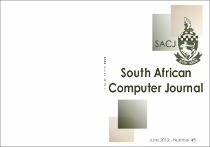 ResearchSpace
ResearchSpace
The design of application-specific heuristics for the usability evaluation of the digital doorway
JavaScript is disabled for your browser. Some features of this site may not work without it.
- ResearchSpace
- →
- Research Publications/Outputs
- →
- Journal Articles
- →
- View Item
| dc.contributor.author |
Adebesin, F

|
|
| dc.contributor.author |
Kotzé, Paula

|
|
| dc.date.accessioned | 2012-07-02T08:46:04Z | |
| dc.date.available | 2012-07-02T08:46:04Z | |
| dc.date.issued | 2012-06 | |
| dc.identifier.citation | Adebesin, F and Kotzé, P. 2012. The design of application-specific heuristics for the usability evaluation of the digital doorway. South African Computer Journal, vol. 48, pp 9-30 | en_US |
| dc.identifier.issn | 1015-7999 | |
| dc.identifier.uri | http://sacj.cs.uct.ac.za/index.php/sacj/article/view/82/43 | |
| dc.identifier.uri | http://hdl.handle.net/10204/5962 | |
| dc.description.abstract | The Digital Doorway (DD) is a joint initiative between the South African Department of Science and Technology (DST) and the Meraka Institute of the Council for Scientific and Industrial Research (CSIR). The DD is a non-standard computer system deployed amongst underprivileged communities in South Africa with the objective to promote computer literacy. Since its inception, there has been no usability or accessibility evaluation of the software installed on the DD, mainly due to lack of usability engineering or interaction design expertise within the development team. The goal of the research presented in this paper was to design a solution to this problem by developing a suitable instrument that could guide DD application developers in the design and development of more usable DD software and interfaces. Design research was used as a research methodology. We first investigated the applicability of the standard usability and accessibility evaluation methods for evaluating the software installed on the DD. During the first cycle of design research, we established that a heuristic-like evaluation method would be an appropriate method for evaluating the usability and direct accessibility support provided by the DD. During a second cycle of design research, embedded in the first, we also developed a set of multi-category heuristics as the ‘instrument’ that could guide the developers during design of applications as well as in the first-level (formative) evaluation thereof. To verify the heuristics, we conducted a usability evaluation of the DD and triangulated the results with a direct field observation at a natural environment of DD use, together with user-administered questionnaires. | en_US |
| dc.language.iso | en | en_US |
| dc.publisher | South African Institute of Computer Scientists and Information Technologists | en_US |
| dc.relation.ispartofseries | Workflow;9193 | |
| dc.subject | Design research | en_US |
| dc.subject | Computer literacy | en_US |
| dc.subject | Heuristic evaluation | en_US |
| dc.subject | Digital doorway | en_US |
| dc.subject | Digital divide | en_US |
| dc.title | The design of application-specific heuristics for the usability evaluation of the digital doorway | en_US |
| dc.type | Article | en_US |
| dc.identifier.apacitation | Adebesin, F., & Kotzé, P. (2012). The design of application-specific heuristics for the usability evaluation of the digital doorway. http://hdl.handle.net/10204/5962 | en_ZA |
| dc.identifier.chicagocitation | Adebesin, F, and Paula Kotzé "The design of application-specific heuristics for the usability evaluation of the digital doorway." (2012) http://hdl.handle.net/10204/5962 | en_ZA |
| dc.identifier.vancouvercitation | Adebesin F, Kotzé P. The design of application-specific heuristics for the usability evaluation of the digital doorway. 2012; http://hdl.handle.net/10204/5962. | en_ZA |
| dc.identifier.ris | TY - Article AU - Adebesin, F AU - Kotzé, Paula AB - The Digital Doorway (DD) is a joint initiative between the South African Department of Science and Technology (DST) and the Meraka Institute of the Council for Scientific and Industrial Research (CSIR). The DD is a non-standard computer system deployed amongst underprivileged communities in South Africa with the objective to promote computer literacy. Since its inception, there has been no usability or accessibility evaluation of the software installed on the DD, mainly due to lack of usability engineering or interaction design expertise within the development team. The goal of the research presented in this paper was to design a solution to this problem by developing a suitable instrument that could guide DD application developers in the design and development of more usable DD software and interfaces. Design research was used as a research methodology. We first investigated the applicability of the standard usability and accessibility evaluation methods for evaluating the software installed on the DD. During the first cycle of design research, we established that a heuristic-like evaluation method would be an appropriate method for evaluating the usability and direct accessibility support provided by the DD. During a second cycle of design research, embedded in the first, we also developed a set of multi-category heuristics as the ‘instrument’ that could guide the developers during design of applications as well as in the first-level (formative) evaluation thereof. To verify the heuristics, we conducted a usability evaluation of the DD and triangulated the results with a direct field observation at a natural environment of DD use, together with user-administered questionnaires. DA - 2012-06 DB - ResearchSpace DP - CSIR KW - Design research KW - Computer literacy KW - Heuristic evaluation KW - Digital doorway KW - Digital divide LK - https://researchspace.csir.co.za PY - 2012 SM - 1015-7999 T1 - The design of application-specific heuristics for the usability evaluation of the digital doorway TI - The design of application-specific heuristics for the usability evaluation of the digital doorway UR - http://hdl.handle.net/10204/5962 ER - | en_ZA |





